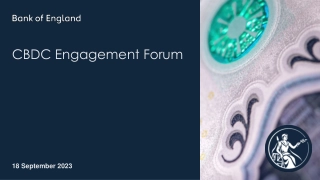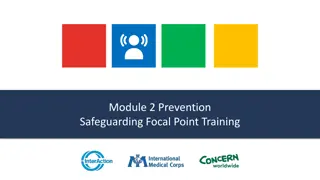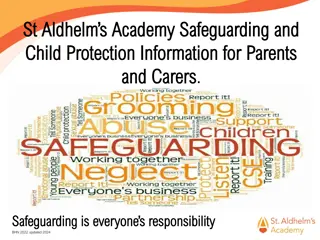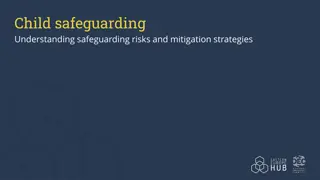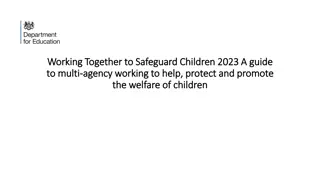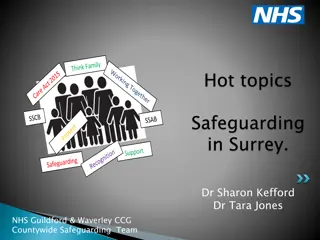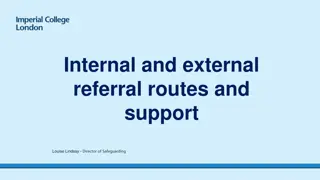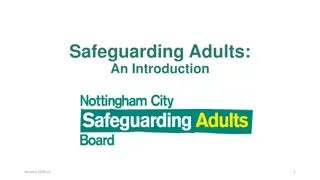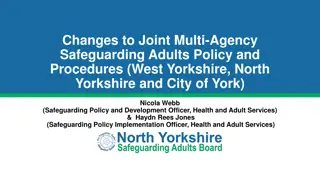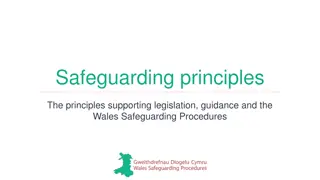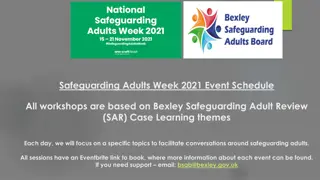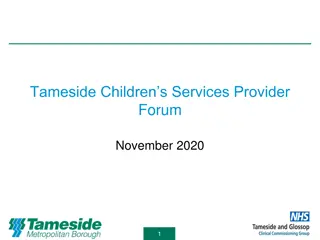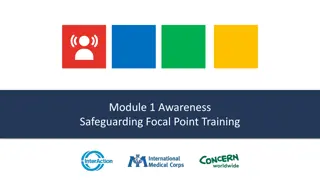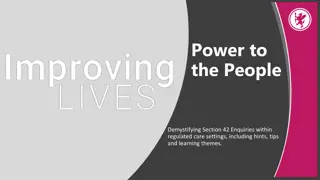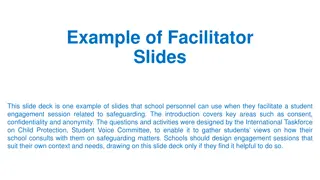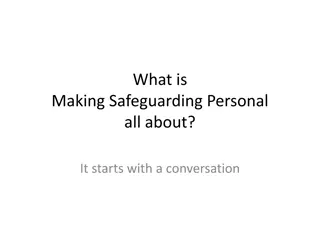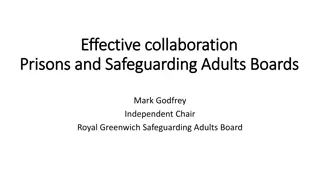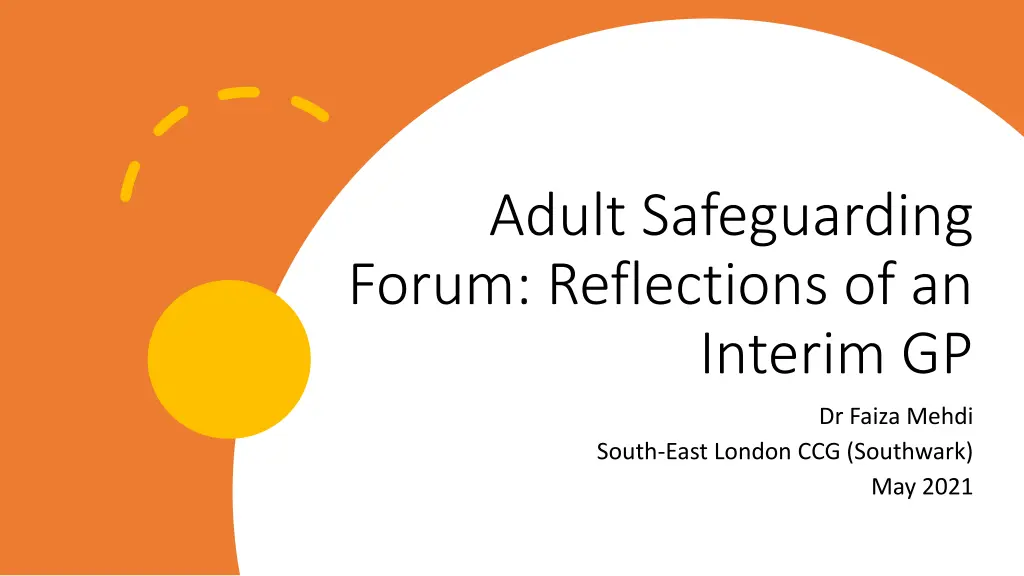
Effective Safeguarding Learning and Documentation in Healthcare
Discover reflections from an interim GP on sharing safeguarding learning effectively, barriers to implementation, and best practices in notes and record-keeping. Learn from insights shared during training sessions on clinical leadership in safeguarding to enhance communication and continuity of care in healthcare settings. Understand the importance of accurate documentation and the key elements to include for effective safeguarding practices.
Download Presentation

Please find below an Image/Link to download the presentation.
The content on the website is provided AS IS for your information and personal use only. It may not be sold, licensed, or shared on other websites without obtaining consent from the author. If you encounter any issues during the download, it is possible that the publisher has removed the file from their server.
You are allowed to download the files provided on this website for personal or commercial use, subject to the condition that they are used lawfully. All files are the property of their respective owners.
The content on the website is provided AS IS for your information and personal use only. It may not be sold, licensed, or shared on other websites without obtaining consent from the author.
E N D
Presentation Transcript
Adult Safeguarding Forum: Reflections of an Interim GP Dr Faiza Mehdi South-East London CCG (Southwark) May 2021
Personal reflection Learning from DHRs and SARs Documentation Reflections of an Interim GP What is most effective way of sharing safeguarding learning? What are the barriers to implementation?
Healthcare is an MDT process and good patient records allow effective communication between health professions Continuity of care record should allow another practitioner to reconstruct and effectively continue care for patient Patients or their relatives may read the notes Documentation and Safeguarding Assume that any entries made in a patient or client record will be scrutinised at some point Taken from Bond Solon Training: Clinical Leadership in Safeguarding March 2021
Documentation The following four slides are taken from Bond Solon training course: Clinical Leadership in Safeguarding (March 2021) Verbal consent given during course to share material
Best Practice in notes and record keeping Notes and Records must include Date Time Place People Present All key times recorded [Time and duration of breaks] Other facts relevant to context. Any non-verbal communications? All relevant facts No assumptions Chronological order Taken from Bond Solon Training: Clinical Leadership in Safeguarding March 2021
Best Practice in notes and record keeping Notes and records must include No erasures No leaves torn out Blank spaces ruled out No overwriting Crossings out initialled by maker/interviewee No writing in margins Clear reference to exhibits/documents/objects Exhibits labelled Recorded all questions/comments/answers Recorded time that notes began and ended Taken from Bond Solon Training: Clinical Leadership in Safeguarding March 2021
Best Practice in notes and record keeping Notes and records must include Recorded where notes made Checked for mistakes Correct grammatical English Clear plain language Description of exhibits, number of exhibits, person producing it, where it was found, where originated, whether copied, where exhibits being secured. Avoided using abbreviations Avoided approximations Did not miss out key words Did not use arrows/dashes Notes capable of acting as contemporaneous notes to refresh memory Identity of author of notes Taken from Bond Solon Training: Clinical Leadership in Safeguarding March 2021
Facts, Assumptions or Opinions Fact or assumption ? In the event that evidence is needed for claims, complaints or other legal proceedings, it is vital that the Healthcare Professional/organisation has accurate records. It is also vital that these records record facts and avoid unaccounted for speculation or assumptions. Healthcare Professionals must record facts and the source of facts, and should not make assumptions or draw inferences without the facts. Fact A fact is what has been seen, heard or done by the writer. Such facts should be recorded contemporaneously if possible. An Assumption/inference A statement about the unknown based on the known. It is vital for Healthcare Professionals to seek and record facts, and not to make assumptions and inferences unless they are based on facts. An opinion The Health Professional will form an opinion based on a fact. Taken from Bond Solon Training: Clinical Leadership in Safeguarding March 2021
n=2 DHRs, n = 2 SARs Issues around how it is managed processes Thornicroft (2020) in The Lancet: people with mental illness are more likely to be victims of violence than perpetrators. Rates of perpetrating violence slightly higher in Schizophrenia and bipolar disorder. Triple morbidity severe mental illness + substance misuse + antisocial PD substantially more likely to be violent Mental Health
Common Themes Victim Perpetrator Minimal contacts Many contacts Often only GP and A&E attendances Multiple agencies involved No documentation of ever being asked about domestic abuse Mental health problems in young men recognized but no robust management plan in place Minimal documentation of social circumstances, including relationships, in GP notes Minimal documentation of (often very difficult) social circumstances, including relationships, in GP notes
Routine enquiry: all service users asked about experience of domestic abuse, regardless of any signs/suspicions of abuse Targeted/Clinical enquiry: low threshold for asking service users about experience of domestic abuse when they present with certain indicators of abuse Domestic Domestic Abuse: Routine Abuse: Routine & Targeted/ & Targeted/ Clinical Enquiry Clinical Enquiry From Ask and Take Action: Why public services must ask about domestic abuse August 2019
IRIS Training Tips Ask For those living with others during lockdown, consider using yes/no questions. Further guidance is available in the folder. Are you having any problems with your husband/partner/anyone at home? Has someone hurt you? Some women have these symptoms when they are at risk of abuse. Are you afraid of anyone at home? Does anyone try to control you or what you do? Sometimes women who have these symptoms/injuries have been frightened or hurt by someone at home. Has anyone s behaviour upset you? Are there things that happen at home that scare you? Are you afraid of anyone at home? Sometimes people with depression/low self-esteem have experienced major life events that cause this and can explain why they feel so low. Living in an abusive relationship can cause this. Might that be happening to you? Respond I believe you. It s not your fault. Support is available. Thank you for telling me Everyone has the right to be safe at home Risk Check Is it safe to go/stay at home? What are you afraid might happen? What has the abuser threatened? What about threats to the children? Please refer to relevant IRIS referral pathway when responding to disclosures of domestic abuse.
Code History of Domestic Abuse as major active problem Document name and relationship of anyone accompanying patient to appointment Name of alleged perpetrator should be documented when DA disclosed Ensure reference to DA on victims record not accidentally visible to anyone else : during consultation print-outs online access Link EMRs of household/family Domestic Domestic Abuse: Abuse: Documentation Documentation & Coding & Coding RCGP Guidance on recording domestic abuse in the electronic medical record
Coding PATTERN RECOGNITION PROBLEM LIST: DYNAMIC, CLEAR
Quality of interpersonal relationships Living conditions and social isolation History of domestic or sexual abuse Employment and immigration status Availability of social support Alcohol and substance misuse Mental Health: Mental Health: Enquiry & Enquiry & Documentation Documentation Taken from NICE Clinical Knowledge Summaries: Depression
Risk factors that increase the risk of suicide: Male Lives alone Unemployed Drug/alcohol dependence High risk groups: Young & middle-aged men In contact with criminal justice system Risk to self & others Mental Health: Mental Health: Enquiry & Enquiry & Documentation Documentation Taken from NICE Clinical Knowledge Summaries: Depression
Which factors need to be considered What can be done to reduce inequalities? e.g. young, male, BAME, autistic with MH problems - consider making IAPT referral for him? Diversity & Inclusion
Continuity of care Follow-up Tackle substance misuse early MDT communication Capacity Social Prescribers Think Family General General Themes Themes
Questions & Questions & Comments Comments

